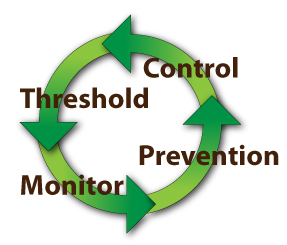In this article, Growers Network discusses the basics of Integrated Pest Management as a solution to pest control in your grow operation.

The following is an article produced by Growers Network. This article is for educational purposes only. We do not claim any responsibility for any legal or financial repercussions of your decisions. Always consult with a lawyer or attorney before making a decision that could have a legal consequence!
Let’s get integrated!
Integrated Pest Management (IPM) is a tested and effective approach to pest control that takes an environmentally sensitive, common sense approach to dealing with pest infestations. IPM uses a variety of strategies that focus on the pest life cycle and its interaction with the environment. Gone are the days of indiscriminate spraying of pesticides that, when relied upon exclusively, can actually make an infestation worse in the long term. The underlying goal of IPM is to control pests economically while at the same time posing the least amount of damage to people, property, and the environment.


How does IPM work?
IPM is more than a single method or strategy. As previously mentioned, it’s a combination of monitoring, data collection, and reporting that inform pest management decisions. IPM typically utilizes the following approach, made up of four parts.
- Action Thresholds: Determine at what level a species becomes a problem. This could be at a certain amount of crop loss or economic damage.
- Monitoring/Identification: What pests are present and in what kind of numbers? How do we identify the pest and watch for it?
- Prevention: Manage space/environment to prevent infestations. This could be as simple as changing into work clothes on-site, or as complex as a negative pressure design to remove pathogens from a facility or room.
- Control: When necessary, apply the least harmful technique available to reduce pests. By least harmful, we mean the fewer harmful chemicals used, the better.
Let’s talk about each of these in a bit more detail...
1. Action Thresholds
An action threshold simply means determining what level of a pest species is acceptable before an action needs to be taken. Determining the level that the pest becomes economically harmful is important for determining specific pest control decisions. While pre-IPM strategies might involve a regularly scheduled application of pesticide, determining action thresholds saves money and is better for the environment. An action threshold is essentially a cost/benefit analysis. If there is some minor damage from a grasshopper or two that snuck into the facility, we don’t need to overreact and spray the whole facility.
2. Monitoring/Identification
Not every organism you find is going to require control due to the fact that they don’t cause harm. You can understand how wasteful and irresponsible it would be to treat a harmless species as an “infestation.” By determining which species are present and in what numbers, you can determine what action should be taken, if any. This goes hand in hand with the action thresholds; through monitoring known pests, we can know when it’s appropriate to apply the safest, most effective, and most appropriate control strategy.

3. Prevention
By managing the environment, we can prevent some infestations from becoming a threat at all. This might include specific strategies such as using pest resistant crop strains and rotating crops, but it can also include things like sealing up windows and cracks, removing debris that could attract pests to your location in the first place, or keeping humidity low to prevent fungal outbreaks. For example, moving a woodpile away from a building will reduce the chance of a termite infestation.
4. Control
If the monitoring/identification protocols inform us that our action threshold has been met, it’s time to implement a control. A good IPM program will then employ the most effective control strategy that also present the least amount of risk. This may include something as simple as hand picking individual pests from plants and using highly targeted viruses that disrupt the pest life cycle. Another strategy would be the introduction of a beneficial insect species or microbe that would combat an infestation naturally (IE Ladybugs v. Aphids). If continued monitoring determines that the less risky control methods aren’t working, a targeted pesticide might be used, and if all else fails, a broadcast spraying of a more general pesticide may be used, but typically this is only done if all else fails.

There you have the basics of IPM. As you plan/implement your grow operation, you should definitely be incorporating these types of practices. Not only will you help the environment and save money on chemical treatments, but you’ll be able to combat pests before they really start to BUG you.
10 Best Gift Ideas for Cannabis Connoisseurs and Growing Aficionados (2022)
December 7, 2022Developing and Optimizing a Cannabis Cultivation System
December 14, 2021Dealing with Insomnia: How Can CBD Help?
December 10, 2020Your Guide to Sleep and CBD
December 7, 2020
Do you want to receive the next Grower's Spotlight as soon as it's available? Sign up below!

Do you have any questions or comments?

About the Author
Chris DeWildt is a graduate of Grand Valley State University and Western Kentucky University. He worked in education and publishing for ten years before joining the team at Growers Network. In addition to editing the GN blog, Chris also works on the Canna Cribs series.